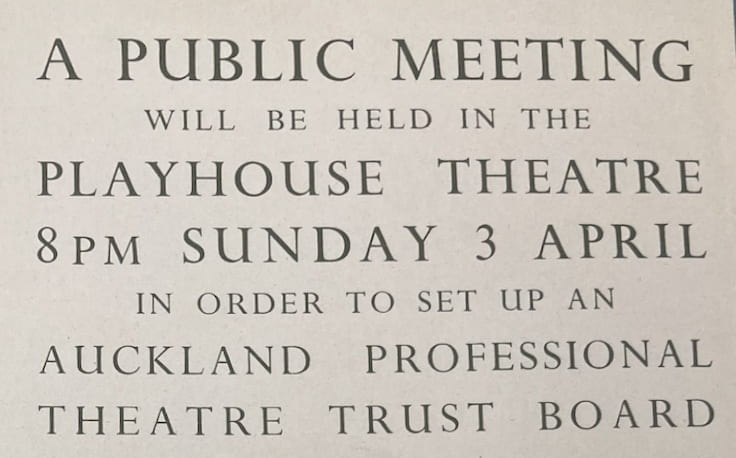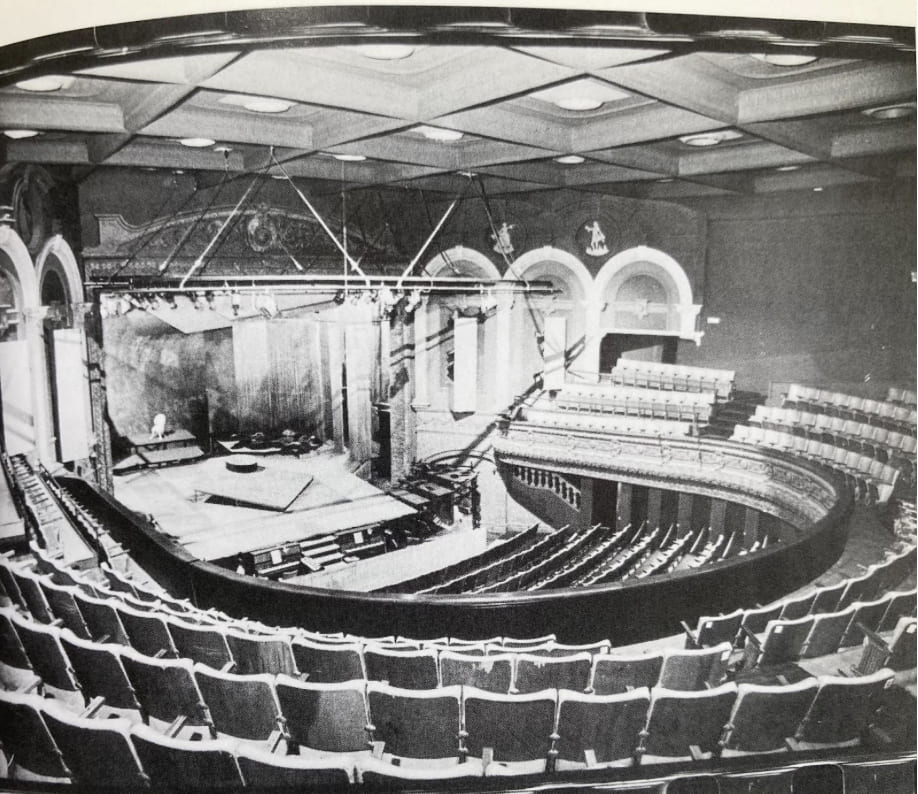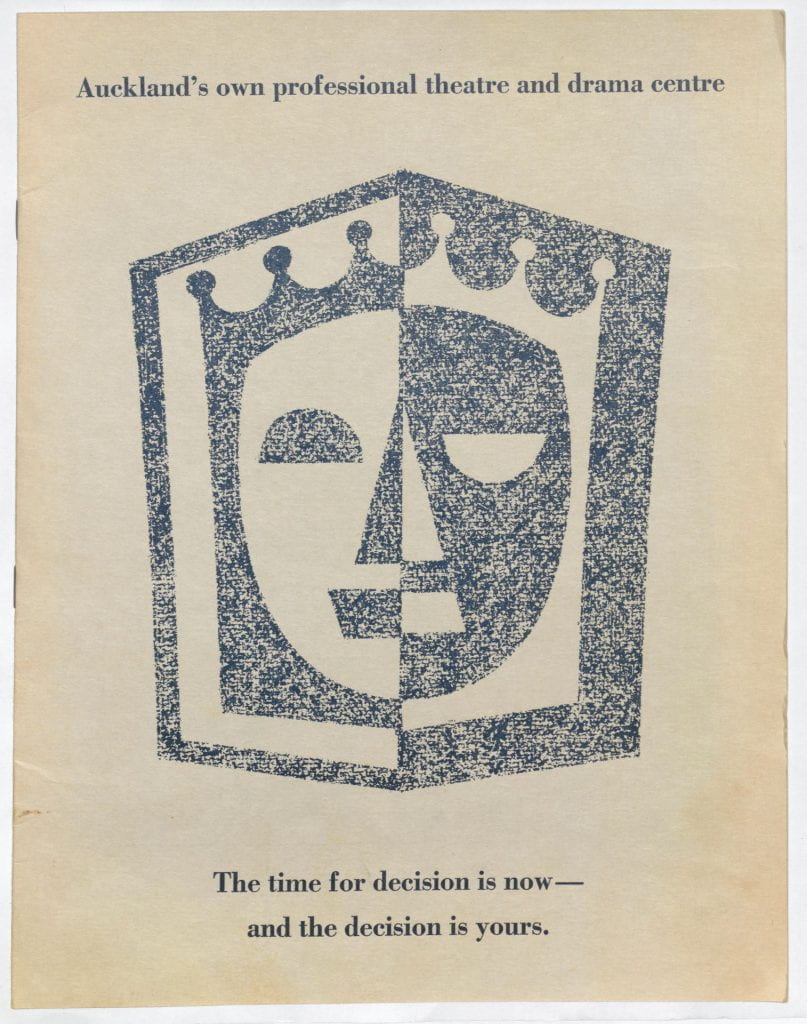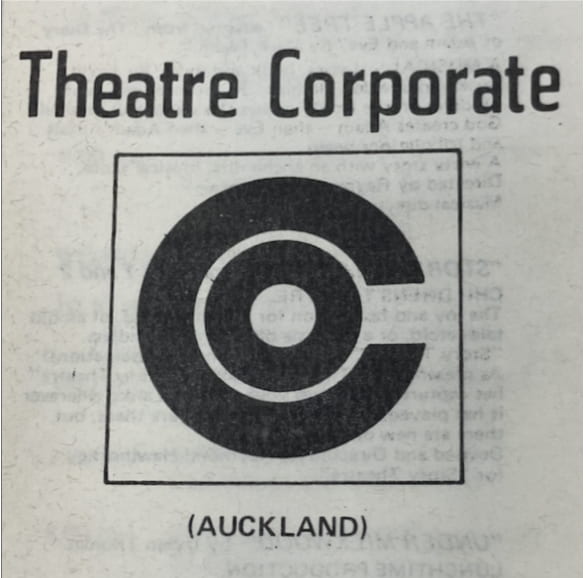Part One
The Rise of Professional Theatre in Auckland
by Anna McCardle*
Introduction to My Research
“Acting training is great for life because it’s the observance… of human behaviour.”
-Linda Cartwright
Just as actors observe human behaviour in order to convincingly bring a character to life, historians seek to authentically bring human activity and worlds of the past to life for a present-day audience.
In highschool, I was passionate about acting. In my Drama classes I could play a character and be someone other than myself. Studying History at University has allowed me to explore time periods and contexts different to my own. The fields of History and Drama both inspire us to conceptualise a world beyond our own, whether that be the world of a character or play, or the world as it was in the past.
In my research for the Auckland History Initiative, I found a collection where these two fields, these two passions of mine, converge. I have been fortunate enough to access Jean Hyland’s Acting Women In Auckland oral history collection, which Hyland donated to Auckland Libraries. In 2005-2006 Hyland conducted 37 interviews with Auckland acting women. The material is vast, covering work experiences in theatre, film, television, radio and more.
Even though I wanted to explore everything, to keep my project manageable, I have narrowed my scope to focus on four acting women interviewed by Hyland, who experienced first-hand, significant evolutions in Auckland theatre from the late 1960s-1980s. These women have all had successful, long and varied careers. Across a series of five articles I will explore their contributions and experiences of Auckland’s acting community and life in theatre. Elizabeth McRae, who acted in Mercury Theatre from its first show in 1968; Andrea Kelland and Linda Cartwright, who both acted in Theatre Corporate in the 1970s; and Justine Simei-Barton, who founded Pacific Theatre in 1987. By taking a microhistory approach, and examining the perspectives of these four women, I can provide a compelling lens into a vibrant and complex era of Auckland theatre.
Moreover, I hope to show how Auckland theatre and these acting women’s experiences were intertwined with broader historical currents: Auckland grappling with developing a local culture that did not defer to the city’s colonial English roots and increasing its representation of its culturally diverse population in spheres like the performing arts, the rise of second wave feminism in Auckland, and changing social pressures on Auckland women.
This first article will consider the rise of professional theatre in late 1960s to early 1970s Auckland. I will track the progress of how a national call for professionalisation in New Zealand theatre set the wheels of change in motion here, resulting in the emergence of Auckland professional theatre companies like Mercury Theatre and Theatre Corporate. The perspectives of Elizabeth McRae, Andrea Kelland, and Linda Cartwright, who acted in these companies, provide valuable insights into their founding and development.
“Something Was Missing”: The National Push for Professional Theatre
In her interview Elizabeth McRae recalled how in 1966 a production of The Comedy of Errors toured New Zealand “in order to… announce that it [professional theatre] was going to happen.” The Comedy of Errors programme advertised a government body, the Queen Elizabeth II Arts Council’s plan, to form The New Zealand Theatre Centre. Its mission was to support the creation of professional theatre companies that would take root in Auckland, Wellington, Christchurch and Dunedin. However, it was not as if there had been no theatre in New Zealand or Auckland prior to the emergence of professional companies. Amateur theatre groups had already facilitated a vibrant and active drama scene. So what was the difference between amateur and professional theatre? Why was advancing professional theatre viewed as a necessary next step?
The Comedy of Errors programme described professional theatre as a national need: “For years the professional dramatic theatre languished under the impact of rising costs, television [which had been introduced into New Zealand in the 1960s, and was feared to be diverting audiences away from the theatres] and lack of finance. Meanwhile New Zealand Ballet and New Zealand Opera developed their potential and have given great nights in the theatre for our people. Still, something was missing.”
The funding and development of professional theatre companies was believed to be the necessary solution to both filling the missing piece in New Zealand Arts, and ensuring that theatre did not decline while television, opera and ballet advanced.
Moreover, Melanie Coddington from The Real Theatre Company in Napier describes the distinction between amateur and professional theatre as “amateur theatre has people involved in theatrical shows for the sheer enjoyment, compared with those who are employed… as a performer or crew behind the scenes. Professionals have often invested time and money to develop their skills… and work with a mindset where creative outlets are their living.” In essence, amateur theatre groups voluntarily put on shows out of their love for drama and performance. Professional companies pay their directors, actors and behind-the-scenes crew to achieve a high standard of shows, merging the vibrancy of a creative space and the diligence of a workspace together. Hence, the development of professional theatre was viewed as a way to elevate the standard of Auckland’s performing arts. As Dr. John Cowie Reid, a University of Auckland professor and Chairman of the Auckland Theatre Trust, expressed in 1966: “Amateur drama is a delightful avocation, but it is an avocation, and not a vocation, hence, however high its standards, it can only supplement and not replace the real standards of professionalism.”
Roy B. Walker, a later Chairman of the Auckland Theatre Trust, wrote in 1973 about how “professional theatre in New Zealand… had all started, and finished, many times before! There had been countless attempts- some local, some national, some static, some touring – but all had failed from lack of support, from lack of economic management, from lack of professionalism.” Indeed, there had been previous ineffective attempts to start professional theatre in New Zealand. Those involved in the 1960s push were determined to be different, and succeed.
“Wit, Eloquence and Commerce”: Setting up Mercury Theatre

Pamphlet, 1966, Auckland Libraries Heritage Collections, EPH-05608
The New Zealand Theatre Centre’s push for professional theatre advancement across the country set the ball rolling in Auckland. The Queen Elizabeth II Arts Council requested that John Reid lead a public effort to set up a professional company in Auckland. On April 3, 1966, a meeting was held at the Playhouse in France Street to form the Auckland Theatre Trust. This was the event where Reid, who subsequently became Chairman, called for Aucklanders to support the establishment of “professional theatre on a permanent basis in Auckland.”
Elizabeth McRae remembered how: “it all seemed possible… it was a great meeting.” Linda Cartwright similarly felt “when the Mercury Theatre started… I think it was then that we thought my God you know, this is possible. Not just ‘semi professional’ or kind of ‘devoted amateur.’” The Auckland Theatre Trust set out to make what seemed possible, a reality.
The Trust chose the Playhouse, which had been a cinema, to be the site of Auckland’s first professional theatre company. The Trust purchased the building from Sir Robert Kerridge in 1967. McRae described the challenge of Auckland’s geography: “Auckland is about the size of London in its geographical spread… so it’s very hard to get people travelling into one… theatre.” The Trust selected the Playhouse because in being located on France Street off Karangahape Road, it was “in the centre of the city where it will be most readily accessible to the greatest number of people.”
McRae’s husband, Donald, redesigned the Playhouse for its new function. The theatre had a main downstairs auditorium with 700 seats, and a smaller upstairs studio space for rehearsals and experimental or late-night productions with 130 seats.

The main auditorium, Nicholas Tarling, Wit, Eloquence and Commerce, A History of Auckland’s Mercury Theatre, (Auckland: Connacht Books, 2007)
Anthony Richardson, who had extensive theatre experience, was recruited from Britain to be a director for the company.

Advertisement calling Auckland actors to audition for the Mercury Theatre company, 1967, Mercury Theatre scrapbook, Auckland Libraries Manuscripts Collection, https://digitalnz.org/records/32983639/mercury-theatre-scrapbook
The company was christened ‘Mercury Theatre.’ In a 1967 progress report for the Trust Board, Richardson outlined the rationale behind this name, which included how “Mercury is not only the god of wit and eloquence, but also of commerce!” Indeed, in order for Mercury Theatre to be able to put on shows full of wit and eloquence, the Theatre Trust had to be adept in commerce. Donations were needed from Auckland “individuals, corporations, institutions and business firms” to support costs like the purchase and remodelling of the Playhouse. The Trust Board put out an advertising campaign in the hopes of attracting donations and also inspiring the public to be interested in attending future shows, so that Mercury Theatre would be filled with paying audiences. Pamphlets and flyers were circulated containing persuasive language that impressed the need for and benefits of having a professional theatre.

Pamphlet, c.1967. University of Auckland Special Collections, John Cowie Reid papers, Auckland Theatre Trust Records, MSS. Archives. 89/14. Series 4. File 17.

Faded pamphlet, c.1967. University of Auckland Special Collections, John Cowie Reid papers, Auckland Theatre Trust Records. MSS. Archives. 89/14. Series 4. File 17
The advertisements invoked Auckland’s competition with other regions: “Now Dunedin, Christchurch, Wellington and Hamilton are well launched on the establishment of their theatres, and only Auckland has lagged behind.”The advertisements also promised Mercury Theatre would elevate Auckland’s maturity and culture: “Auckland citizens are coming to realise that, for their city to be a truly mature community, commercial and industrial progress needs to be matched by cultural progress.” Further, the advertisements went on to describe the Mercury as servicing the community, promising theatrical employment for Auckland actors and stage crew, and enjoyment for Auckland audiences: “This is not a commercial enterprise, but a community venture. The Auckland Theatre will belong to the people of Auckland.”
The fundraising, the remodelling of the Playhouse, the recruitment of actors and stage crew all culminated in this momentous coverage in the New Zealand Herald, on May 1, 1968. The article read, “As the curtain rises tonight on the first act of J. M. Barrie’s ‘The Admirable Crichton’ the new Mercury Theatre will make its long-awaited debut as Auckland’s first professional theatrical company.”
McRae played Lady Mary Lasenby in the Mercury’s debut production. She loved rehearsing with the company for the first time, recounting “It was such a joy,” but felt The Admirable Crichton “didn’t quite work, it didn’t work really at all I guess but it was a beginning.” Although McRae thought the performance was a rather shaky start, it still marked the beginning of actors gaining professional employment in Auckland. From then, the Mercury Theatre employed around 12 to 16 full time performers.

Illustration from N.Z. Herald, May 1, 1968, 7. Mercury Theatre scrapbook, Auckland Libraries Manuscripts Collection, https://digitalnz.org/records/32983639/mercury-theatre-scrapbook
On May 1, 1971, Roy Walker, then Chairman of the Auckland Theatre Trust, documented the Mercury’s successful trajectory exactly three years after its first show. Over 250,000 Aucklanders had come to its shows, and it was the “sole full-time [putting on plays year-round] professional theatre in New Zealand.”
“Bringing Theatre to Schools”: Theatre Corporate
After the Mercury Theatre set the precedent that professional theatre could successfully operate in Auckland, Theatre Corporate was formed in 1973. It was an Auckland professional theatre company which was distinctive for its close engagement with primary and secondary schools. Raymond Hawthorne, the company’s founder and director, was a New Zealander who had gone to England to train with the Royal Academy of Dramatic Arts. He returned and, as Linda Cartwright remembered, “must have chosen people that he liked the look of” as actors to work for him. Cartwright and Andrea Kelland were among those he selected.
In 1974, Hawthorne set up Story Theatre, a small group that included Kelland, which toured Auckland and North Island primary schools performing tales, fables and legends. As a promotional pamphlet for Theatre Corporate described, “the success of this series of tales and fables and the need expressed by Primary school teachers led to the formation of a full-time professional company.

”Faded Story Theatre logo, Back in the Dreamtime programme, June, 1975, Auckland Libraries Heritage Collections, EPH-06192
Their success escalated in 1975, when there was a demand for performers to also tour Auckland and North Island secondary schools. Hawthorne created the Theatre in Education company, which included both Kelland and Cartwright, to do just this. In 1976, Theatre Corporate moved into the Galatos Street Theatre in central Auckland. Elizabeth McRae, who did some voice teaching and acting for the company, recalled how the theatre was renovated “by the actors themselves.” This change in location showed how far the company had come, after starting out, as McRae remembered, rehearsing in “scungy rooms in Karangahape Road; no electricity, so candles [were] used at [the] first meeting.”
Roger Hall praised the impact Theatre Corporate had on schools in a review of their 1975 production, Back in the Dream Time, performed at MacAndrew Hall in Titirangi:
“There is no ‘playing down’ to children about any of it. Indeed, this form of presentation assumes relatively high theatrical maturity among youngsters–and correctly so, to judge from the engrossed appreciation of the kiddies. This venture deserves the greatest success in bringing a stimulating and imaginative aspect of theatre to schools.”
Theatre Corporate’s touring shows exposed and engaged youth in primary and secondary schools to the theatre. Moreover, Cartwright recalled how after some of the shows, the performers would run acting workshops with the students. This initiative likely encouraged these children to foster an interest in theatre or inspired them to become a future generation of actors and theatre-professionals.

Theatre Corporate Logo, Family Festival of Theatre Programme, Theatre Corporate. Hastings City Cultural Centre, August-September, 1975. Auckland Libraries Heritage Collections, Eph-06192.
In her interview, Kelland believed that theatre should be more frequently brought to schools in the present day: “It’s a whole area of work that the kids fresh out of drama school that… would be really good for them to be in and plus it would be training up new audiences for the future as well.”
Beyond bringing the theatre to schools, Theatre Corporate, like Mercury Theatre, offered actors like Cartwright and Kelland professional employment, paying a company of 13 actors by 1975. The late 1960s and early 1970s saw the beginning of professional theatre companies in Auckland. History professor and Auckland Theatre Trust Board member, Nicholas Tarling contended that while the Mercury and Theatre Corporate were “flourishing, Aucklanders enjoyed a range of theatrical opportunities such as they had never enjoyed before, nor have enjoyed since.” Indeed, Mercury and Theatre Corporate were committed to providing a plentiful amount of shows to the public, at Mercury’s city theatre and in Theatre Corporate’s school tours. They initiated a vibrant and active era in Auckland theatre.
My next article will provide a close-up look at the Auckland acting women within Mercury Theatre and Theatre Corporate. Elizabeth McRae, Linda Cartwright and Andrea Kelland’s inside perspectives paint a detailed picture of the exciting yet demanding work environment of these professional theatre companies.
